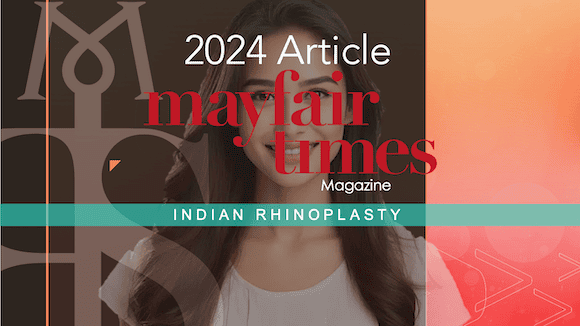
Indian rhinoplasty is a specialised form of nasal surgery that addresses the unique anatomical features commonly found among individuals from the Indian subcontinent, including Pakistan, Sri Lanka, and Bangladesh. This procedure requires a nuanced understanding of regional nasal characteristics to achieve harmonious and natural-looking results.
Award winning Rhinoplasty Surgeon, our Consultant Rhinoplasty Surgeon was voted “Best Cosmetic Surgeon 2015” at the National Aesthetic Awards this year, performing over 300 Rhinoplasty patients with all first time success rates.
Patients seeking Indian rhinoplasty often present with specific features that differentiate them from other ethnic groups. Recognising these traits is crucial for surgeons aiming to deliver optimal outcomes.
A prevalent characteristic among Indian patients is a thicker skin envelope over the nose. This can obscure the underlying structural changes made during surgery, necessitating more pronounced modifications to the bone and cartilage to ensure visible results. Surgeons must carefully sculpt the nasal framework to project the desired shape through the dense skin layer.
Drooping tip, alternatively known as a ptotic nasal tip, is a distinct feature that gives the nose a drooping appearance. A drooping nose is easily noticeable from a side view. It is possible to alter this drooping feature. A drooping nose can be a prominent feature in the face because the tip might seem like it is drooping downwards. Further, a drooping nose might give the face an older appearance. The change made to the tip cartilage will look specifically at the light reflection of your forward-facing profile and the distance between the nasal tip and upper lip.
The dorsal hump is a bump on the bridge of the nose. Some people of Indian origin might have the dorsal hump on the bridge of their noses. This hump creates a convex contour, which is more noticeable through a side view. This hump can give the nose an elongated look and make it a prominent feature on the face. A combination of a dorsal hump and drooping tip can enhance this appearance. But by reducing the cartilage of the nasal hump, and sometimes shaving of the bone in prominent humps, the surgeon can create a smoother nasal bridge finish that is consistent in angle from the forehead down to the nasal tip.
The best Indian rhinoplasty surgeons understand that the goal is not to “Westernise” the nose, but to enhance it while retaining the cultural and ethnic features that define each patient’s face.
This includes:
Avoiding over-reduction of the nose
Maintaining harmony with broader facial features
Creating a nose that looks natural, not operated on
An experienced rhinoplasty surgeon can work on the above-mentioned features by making minimal adjustments to the nose. Furthermore, your surgeon will look to retain the ethnicity of your facial features after making the changes to your nasal profile. The face remains consistent because the minimal alteration preserves the Indian facial features.
You may be a suitable candidate if:
You are of Indian or South Asian descent with nasal features you’d like to improve
You have realistic expectations and clear aesthetic goals
You’re in good physical and mental health
You’re committed to following pre- and post-operative instructions
Finding the right surgeon is the most critical part of your rhinoplasty journey.
Look for:
A facial plastic surgeon with specific experience in ethnic rhinoplasty
Before-and-after photos of previous Indian or South Asian patients
Transparent discussion of risks, limitations, and goals
An artistic eye combined with surgical precision
Yes. The thicker skin, cartilage structure, and aesthetic goals of Indian rhinoplasty require a more customised and skilful approach.
It can significantly improve shape and proportion, but the best outcomes retain your identity while enhancing balance and symmetry.
Most patients experience discomfort rather than pain. Modern techniques and medications ensure a relatively smooth recovery.
For more information about having a rhinoplasty consultation, the different types of rhinoplasty, procedure, and recovery, visit our Rhinoplasty Page.